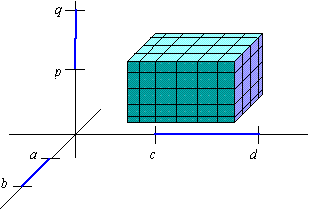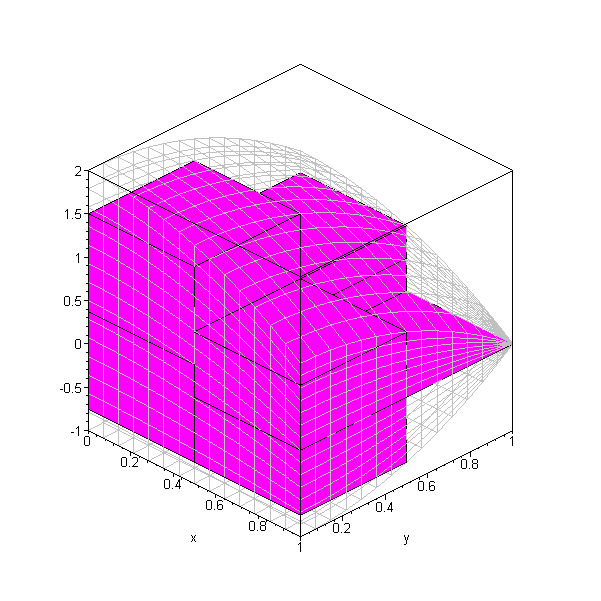Part 1: Definition of the Triple Integral
We can extend the concept of an integral into even higher dimensions.
Indeed, in this section we develop the concept of a triple integral
as an extension of the double integral definition.
To begin with, the notation [ a,b] ×[ c,d]×[ p,q] denotes the parallelepiped whose width, length,
and height correspond to [ a,b] , [ c,d] , and [ p,q] , respectively, and let { xj,tj} , { yk,uk} , and { zl,vl} denote
tagged partitions of those intervals, respectively,

Given a function f( x,y,z) of 3 variables, its Riemann sum
over this partition of the parallelepiped [ a,b] ×[c,d] ×[ p,q] is given by
|
|
m
å
j = 1
|
|
n
å
k = 1
|
|
p
å
l = 1
|
f(tj,uk,vl) DxjDykDzl |
|
The limit as h1,h2, and h3 approach 0 of h1,h2 and h3 fine partitions, respectively, yields the triple integral over
a parallelepiped.
|

|
| [ a,b] ×[ c,d] ×[ p,q] |
|
f( x,y,z) dV = |
lim
h1,h2,h3®0
|
|
m
å
j = 1
|
|
n
å
k = 1
|
|
o
å
l = 1
|
f(tj,uk,vl) DxjDykDzl |
|
For an arbitrary bounded solid S, we define g( x,y,z) = f( x,y,z) if ( x,y,z) is in S and we define g( x,y,z) = 0 otherwise.
As a result, the solid is "approximated" by a collection of
"small boxes" with volume Dxj Dyk Dzl .

click to change the viewpoint
As a result, we can define the triple
integral of f( x,y,z) over an arbitrary solid S by
 |
f( x,y,z) dV = |
|

|
| [ a,b] ×[ c,d] ×[ p,q] |
|
g( x,y,z) dV |
|
where [ a,b] ×[ c,d] ×[ p,q]
contains S.
For example, if f( x,y) ³ g( x,y) over a region R in the xy-plane, then the triple integral of f( x,y,z) over the solid S bound between two surfaces z = g( x,y) and z = f( x,y) over the region R is given by
|
|
 |
f( x,y,z) dV = |
 |
é
ë
|
|
ó
õ
|
f( x,y)
g(x,y)
|
f( x,y,z) dz |
ù
û
|
dA |
| (1) |
where dA is the area differential in the xy-plane.
EXAMPLE 1 Compute the triple integral of f(x,y,z) = 8xyz over the solid between z = 0 and z = 1 and over the
region
Solution: To do so, we use (1) to write
 |
8xyz dV |
|
|
 |
ó
õ
|
1
0
|
8xyz dz dA |
| |
|
 |
4xyz2| 01 dA |
| |
|
 | 4xy dA |
|
|
We then evaluate the resulting double integral over R:
 |
8xyz dV = |
ó
õ
|
1
0
|
|
ó
õ
|
3
2
|
4xy dydx = 5 |
|
Likewise, if p( y,z) ³ q( y,z) over a
region R in the yz-plane, then the triple integral of f(x,y,z) over the solid S bound between the two surfaces x = q(y,z) and x = p( y,z) over the region
R is given
by
|
|
 |
f( x,y,z) dV = |
 |
é
ë
|
|
ó
õ
|
p( x,y)
q(y,z)
|
f( x,y,z) dx |
ù
û
|
dA1 |
|
where dA1 is the area differential in the yz-plane. Moreover, if f( x,y,z) = 1, then the triple integral yields the volume of S
|
Volume of S = |
 |
dV |
|
EXAMPLE 2 What is the volume of the solid between x = yz and x = 0 over the region y = 0, y = 1, z = 0, z = 4.
Solution: The volume is given by
|
V = |
 |
dV = |
 |
ó
õ
|
yz
0
|
dx dA1 |
|
Indeed, substituting the boundaries for R leads to the triple
iterated integral
|
V = |
ó
õ
|
4
0
|
|
ó
õ
|
1
0
|
|
ó
õ
|
yz
0
|
dxdydz |
|
Evaluating each integral in succession then leads to
|
V = |
ó
õ
|
4
0
|
|
ó
õ
|
1
0
|
yz dydz = |
ó
õ
|
4
0
|
z |
y2
2
|
ê
ê
|
y = 1
y = 0
|
dz = |
ó
õ
|
4
0
|
|
z
2
|
dz = 4 |
|
Check Your Reading: What type of solid is described in
example 1?






